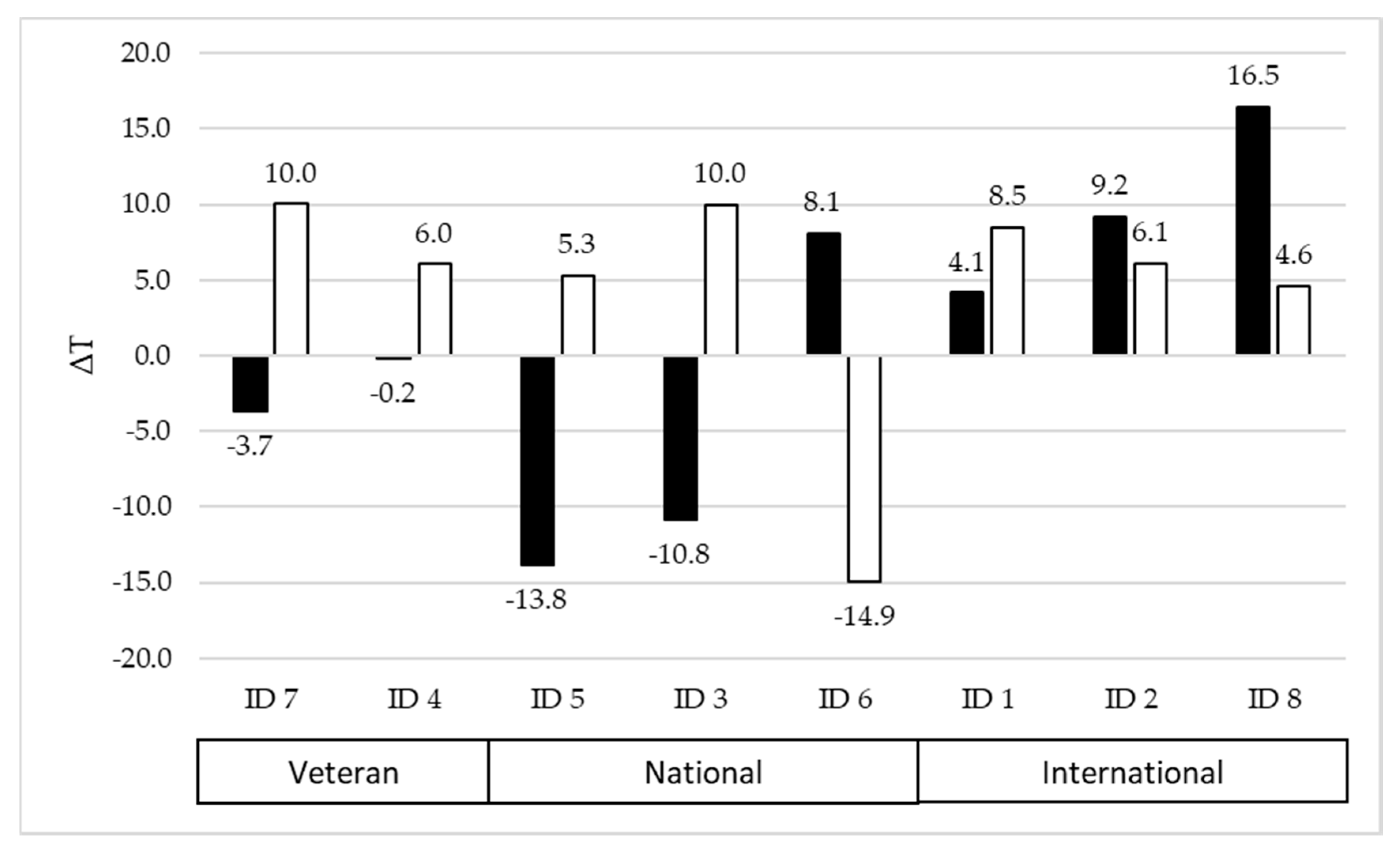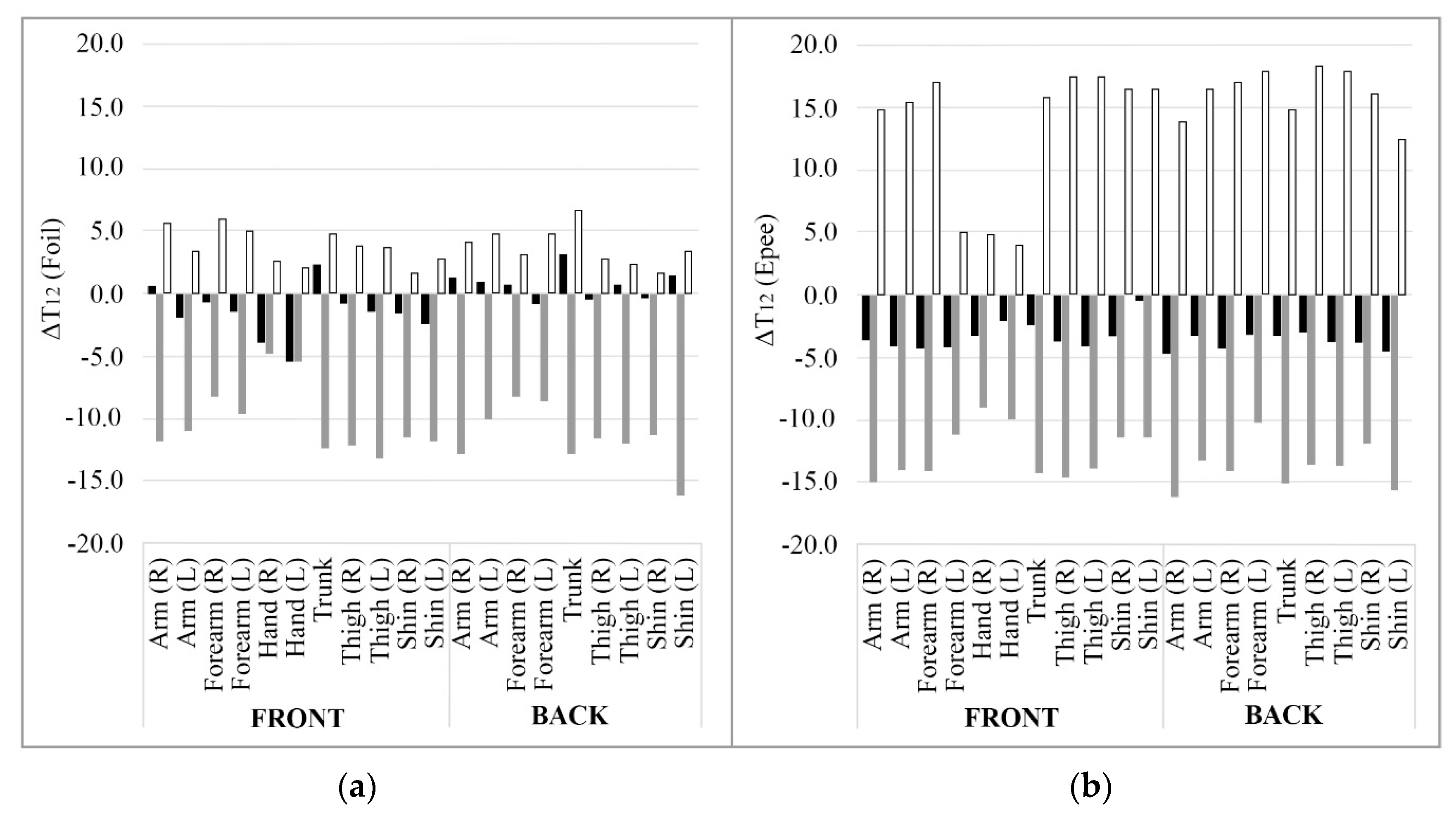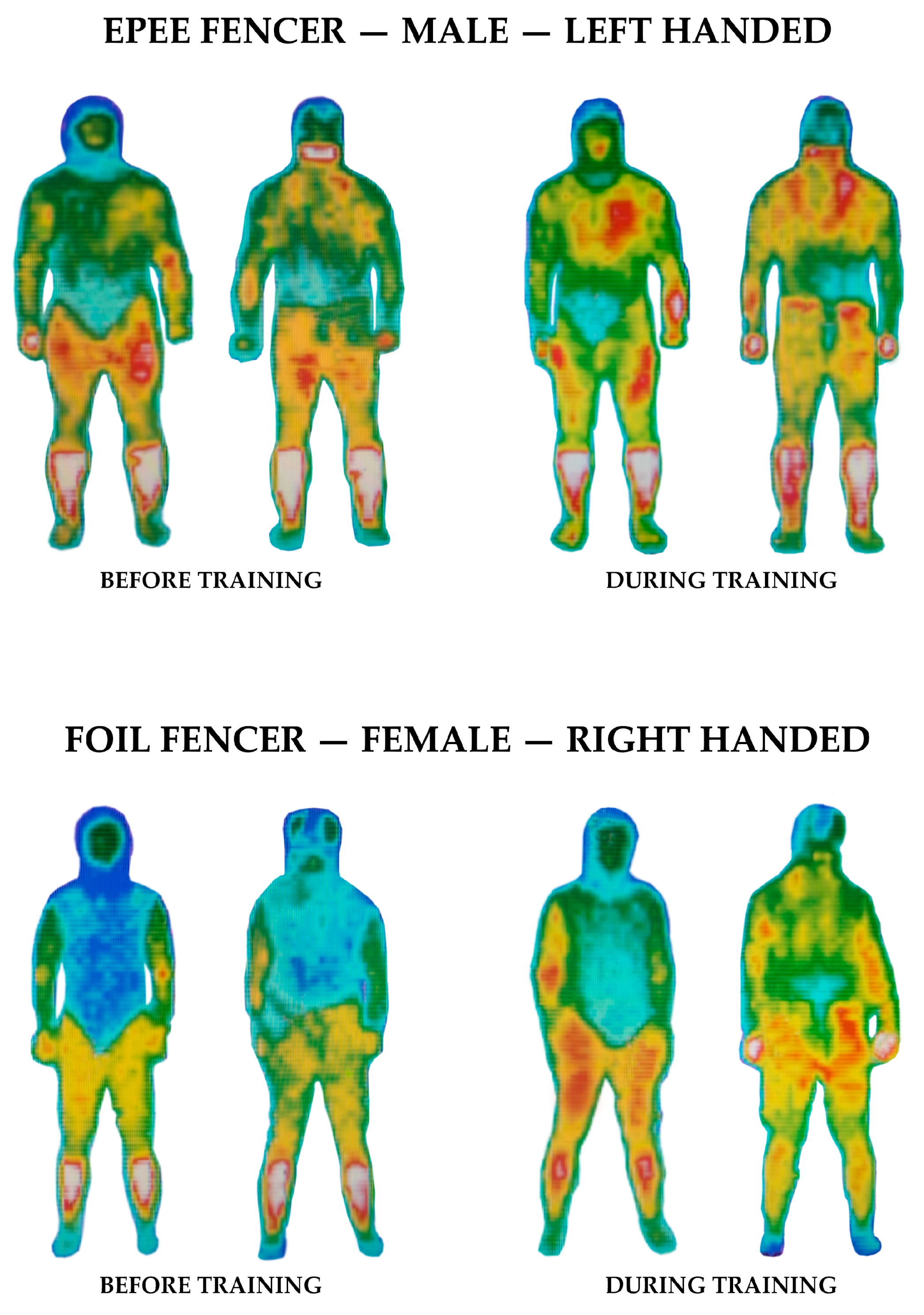Effect of Exercise on Athletes Performing in Fencing Uniforms: Methodology and Preliminary Results of the Use of Infrared Thermography to Detect the Thermal Behaviour of Fencers
Abstract
Featured Application
Abstract
1. Introduction
2. Materials and Methods
2.1. Selection of Participants
- -
- Sex;
- -
- Age;
- -
- Body surface;
- -
- Injuries;
- -
- Level of competition (physical fitness level);
- -
- Weapon performed.
2.2. Evaluation of the Measurements’ Location
2.3. Selection of the Measuring Equipment
2.4. Definition of the Regions of Interest (ROIs)
2.5. Measurement Procedure
2.6. Methodology of Data Elaboration
3. Results
3.1. Estimation of the Metabolic Rate
3.2. Rate of Perceived Exertion (RPE)
3.3. Mean Temperature Differences of the Whole Body
3.4. Mean Temperature differences on the Body Parts
4. Discussion
5. Conclusions
Supplementary Materials
Author Contributions
Funding
Acknowledgments
Conflicts of Interest
References
- Ludwig, N.; Formenti, D.; Gargano, M.; Alberti, G. Skin temperature evaluation by infrared thermography: Comparison of image analysis methods. Infrared Phys. Technol. 2014, 62, 1–6. [Google Scholar] [CrossRef]
- Choi, J.K.; Miki, K.; Sagawa, S.; Shiraki, K. Evaluation of mean skin temperature formulas by infrared thermography. Int. J. Biometeorol. 1997, 41, 68–75. [Google Scholar] [CrossRef]
- Ring, E.F.J. The historical development of temperature measurement in medicine. Infrared Phys. Technol. 2007, 49, 297–301. [Google Scholar] [CrossRef]
- Hardy, J.D. The radiation of heat from the human body. J. Clin. Investig. 1934, 13, 615–620. [Google Scholar] [CrossRef] [PubMed]
- Ring, E.F.J.; Ammer, K. Infrared thermal imaging in medicine. Physiol. Meas. 2012, 33, 33–46. [Google Scholar] [CrossRef] [PubMed]
- Lahiri, B.B.; Bagavathiappan, S.; Jayakumar, T.; Philip, J. Medical applications of infrared thermography: A review. Infrared Phys. Technol. 2012, 55, 221–235. [Google Scholar] [CrossRef]
- Fernández-Cuevas, I.; Bouzas Marins, J.C.; Arnáóiz Lastras, J.; Gómez Carmona, P.M.; Pinoñosa Cano, S.; García-Concepción, M.A.; Sillero-Quintana, M. Classification of factors influencing the use of infrared thermography in humans: A review. Infrared Phys. Technol. 2015, 71, 28–55. [Google Scholar] [CrossRef]
- Keyl, W.; Lenhart, P. Thermography in sport injuries and lesions of the locomotor system due to sport. Fortschr. Med. 1975, 93, 124–126. [Google Scholar]
- Clark, R.P.; Mullan, B.J.; Pugh, L.G. Skin temperature during running—A study using infra-red colour thermography. J. Physiol. 1977, 267, 53–62. [Google Scholar] [CrossRef]
- Maior, A.S.; Leporace, G.; Tannure, M.; Marocolo, M. Profile of infrared thermography in elite soccer players. Mot. Rev. Educ. Fis. 2017, 23, 2. [Google Scholar] [CrossRef]
- De Rade Fernandes, A.; Mendonca Pimenta, E.; Gomes Moreira, D.; Bouzas Marins, J.C.; Silami Garcia, E. Application of Infrared Thermography in the Assessment of Muscle Damage in Elite Soccer Athletes. Orthop. Rheumatol. 2017, 8, 5. [Google Scholar] [CrossRef]
- Arfaoui, A.; Polidori, G.; Taiar, R.; Popa, C. Infrared Thermography in Sports Activity. In Infrared Thermography; Prakash, R., Ed.; IntechOpen: London, UK, 2012; pp. 141–168. [Google Scholar] [CrossRef][Green Version]
- Ludwig, N.; Trecroci, A.; Gargano, M.; Formenti, D.; Bosio, A.; Rampinini, E.; Alberti, G. Thermography for skin temperature evaluation during dynamic exercise: A case study on an incremental maximal test in elite male cyclists. Appl. Opt. 2016, 55, 126–130. [Google Scholar] [CrossRef] [PubMed]
- Tanda, G. Skin temperature measurements by infrared thermography during running exercise. Exp. Ther. Fluid Sci. 2016, 71, 103–113. [Google Scholar] [CrossRef]
- Tanda, G. Total body skin temperature of runners during treadmill exercise. J. Ther. Anal. Calorim. 2018, 131, 1967–1977. [Google Scholar] [CrossRef]
- Vardasca, R.; Seixas, A.; Gabriel, J.; Vilas-Boas, J. Infrared Thermography in Water Sports. In Application of Infrared Thermography in Sports Science; Priego Quesada, J.I., Ed.; Springer: New York, NY, USA, 2017; pp. 137–157. [Google Scholar] [CrossRef]
- Del Estal, A.; Brito, C.J.; Galindo, V.E.; Lopez Diaz de Durana, A.; Franchini, E.; Sillero-Quintana, M. Thermal asymmetries in striking combat sports athletes measured by infrared thermography. Sci. Sport 2017, 32, 61–67. [Google Scholar] [CrossRef]
- Priego Quesada, J.I.; Cibrián Ortiz de Anda, R.M.; Pérez-Soriano, P.; Salvador Palmer, R. Introduction: Historical Perspective of Infrared Thermography and Its Application in Sport Science. In Application of Infrared Thermography in Sports Science; Priego Quesada, J.I., Ed.; Springer: New York, NY, USA, 2017; pp. 1–23. [Google Scholar] [CrossRef]
- Formenti, D.; Merla, A.; Priego Quesada, J.I. The Use of Infrared Thermography in the Study of Sport and Exercise Physiology. In Application of Infrared Thermography in Sports Science; Priego Quesada, J.I., Ed.; Springer: New York, NY, USA, 2017; pp. 111–136. [Google Scholar] [CrossRef]
- Fernández-Cuevas, I.; Lastras, A.J.; Galindo, E.V.; Carmona, P.G. Infrared Thermography for the Detection of Injury in Sports Medicine. In Application of Infrared Thermography in Sports Science; Priego Quesada, J.I., Ed.; Springer: New York, NY, USA, 2017; pp. 81–110. [Google Scholar] [CrossRef]
- Soroko, M.; Davies Morel, M.C.G.; Howell, K. The Application of Infrared Thermography in Equestrian Sport. In Application of Infrared Thermography in Sports Science; Priego Quesada, J.I., Ed.; Springer: New York, NY, USA, 2017; pp. 265–296. [Google Scholar] [CrossRef]
- Fournet, D.; Havenith, G. Assessment of Sport Garments Using Infrared Thermography. In Application of Infrared Thermography in Sports Science; Priego Quesada, J.I., Ed.; Springer: New York, NY, USA, 2017; pp. 159–183. [Google Scholar] [CrossRef]
- Luong, M.P. Assessment of Equipment Using Infrared Thermography in Sports. In Application of Infrared Thermography in Sports Science; Priego Quesada, J.I., Ed.; Springer: New York, NY, USA, 2017; pp. 185–209. [Google Scholar] [CrossRef]
- Priego Quesada, J.I.; Kunzler, M.R.; Carpes, F.P. Methodological Aspects of Infrared Thermography in Human Assessment. In Application of Infrared Thermography in Sports Science; Priego Quesada, J.I., Ed.; Springer: New York, NY, USA, 2017; pp. 49–79. [Google Scholar] [CrossRef]
- Marins, J.; Fernández Cuevas, I.; Arnaiz-Lastras, J.; Fernandes, A.A.; Quintana, M. Applications of Infrared Thermography in Sports. A Review. Rev. Int. Med. Cienc. Act. Fis. Deporte 2015, 15, 805–824. [Google Scholar]
- Tanda, G. The use of infrared thermography to detect the skin temperature response to physical activity. In Proceedings of the 33rd UIT (Italian Union of Thermo-fluid dynamics) Heat Transfer Conference, L’Aquila, Italy, 22–24 June 2015. [Google Scholar]
- Akimov, E.B.; Son’kin, V.D. Skin temperature and lactate threshold during muscle work in athletes. Hum. Physiol. 2011, 37, 621–628. [Google Scholar] [CrossRef]
- Cholewka, A.; Kasprzyk, T.; Stanek, A.; Sieroń-Stołtny, K.; Drzazga, Z. May thermal imaging be useful in cyclist endurance tests? J. Ther. Anal. Calorim. 2016, 123, 1973–1979. [Google Scholar] [CrossRef]
- Gómez-Carmona, P.M.; Noya-Salces, J.; Núñez, J.; Fernández-Rodríguez, I.; Sillero-Quintana, M. Validation of infrared thermography as injury prevention method in professional soccer players. In Proceedings of the 14th Annual Congress of the European College of Sport Sciences, Oslo, Norway, 24–27 June 2009. [Google Scholar]
- Arnaiz-Lastras, J.; Fernández-Cuevas, I.; Gómez-Carmona, P.M.; Sillero-Quintana, M.; García, M.Á.; Piñonosa, C.S. Pilot study to determinate thermal asymmetries in judokas. In Proceedings of the 16th Annual Congress of the European College of Sport Sciences, Liverpool, UK, 6–9 July 2011. [Google Scholar]
- British Researcher Investigates the Science of Fencing. Available online: https://www.fencing.net/17086/british-researcher-investigates-the-science-of-fencing/ (accessed on 15 February 2020).
- Hot Fencer in Uniform! Available online: https://www.leonpaul.com/blog/hot-fencer-in-uniform/ (accessed on 19 February 2020).
- Havenith, G. Human surface to mass ratio and body core temperature in exercise heat stress—A concept revisited. J. Ther. Biol. 2001, 26, 387–393. [Google Scholar] [CrossRef]
- BSI. Protective Clothing—Hand, Arm, Chest, Abdomen, Leg, Genital and Face Protectors for Fencers—Requirements and Test Methods: BS EN 13567; BSI: London, UK, 2002. [Google Scholar]
- PCE–Infrared Thermography Mod. PCE-TC30. Available online: http://www.pce-italia.it/html/data-sheet/Datasheet-PCE-TC_30.pdf (accessed on 5 March 2020).
- PCE–Humidity Meter for Temperature and Humidity. Available online: https://www.industrial-needs.com/technical-data/humidity-detector-PCE-HT-110.htm (accessed on 5 March 2020).
- Priego Quesada, J.I.; Lucas-Cuevas, A.G.; Palmer, R.S.; Perez-Soriano, P.; De Anda, R.M.C.O. Definition of the thermographic regions of interest in cycling by using a factor analysis. Infrared Phys. Technol. 2016, 75, 180–186. [Google Scholar] [CrossRef]
- Ammer, K. The Glamorgan Protocol for recording and evaluation of thermal images of the human body. Ther. Int. 2008, 18, 125–129. [Google Scholar]
- Borg, G. Borg’s Perceived Exertion and Pain Scales; Human Kinetics: Champaign, IL, USA, 1998; pp. 29–38. [Google Scholar]
- Milia, R.; Roberto, S.; Pinna, M.; Palazzolo, G.; Sanna, I.; Omeri, M.; Piredda, S.; Migliaccio, G.; Concu, A.; Crisafulli, A. Physiological responses and energy expenditure during competitive fencing. Appl. Physiol. Nutr. Metab. 2013, 39, 234–328. [Google Scholar] [CrossRef] [PubMed]
- Turner, A.N. Physical Preparation for Fencing: Tailoring Exercise Prescription and Training Load to the Physiological and Biomechanical Demands of Competition. Ph.D. Thesis, Middlesex University, London, UK, 2015. [Google Scholar]
- Chen, T.L.; Wong, D.W.; Wang, Y.; Ren, S.; Yan, F.; Zhang, M. Biomechanics of fencing sport: A scoping review. PLoS ONE 2017, 12, e0171578. [Google Scholar] [CrossRef] [PubMed]





| ID | Sex | Age (years) | Height (m) | Weight (kg) | BSA (m2) | BMI (kg/m2) | Weapon | Competition Level |
|---|---|---|---|---|---|---|---|---|
| 1 | F | 29 | 1.72 | 61 | 1.72 | 20.62 | Foil | International |
| 2 | M | 17 | 1.74 | 72 | 1.86 | 23.78 | Foil | International |
| 3 | M | 22 | 1.83 | 80 | 2.02 | 23.89 | Foil | National |
| 4 | M | 49 | 1.70 | 86 | 1.97 | 29.76 | Foil | Veteran |
| 5 | F | 21 | 1.67 | 58 | 1.65 | 20.80 | Epee | National |
| 6 | F | 24 | 1.74 | 68 | 1.82 | 22.46 | Epee | National |
| 7 | M | 24 | 1.79 | 82 | 2.01 | 25.59 | Epee | Veteran |
| 8 | M | 25 | 1.80 | 78 | 1.97 | 24.07 | Epee | International |
| Technical Specifications PCE TC-30 Thermal Camera | |
|---|---|
| Resolution of the sensor | 80 pixels × 80 pixels |
| Measurement range | 0–250 °C |
| Display | LCD (320 pixels × 240 pixels) |
| Thermal sensibility | 80 mk |
| Frequency | 50 Hz |
| Operative Temperature | 0–50°C |
| Before the training (10 min after entering) | Standing in the fencing hall, 10 minutes | |
| During the training (after 1 h of fencing) | ID 1 | 5 assaults, 55 min—Standing (rest), 5 min |
| ID 2 | 5 assaults, 50 min—Standing (rest), 10 min | |
| ID 3 | 4 assaults, 50 min—Standing (rest), 10 min | |
| ID 4 | 4 assaults, 45 min—Standing (rest), 15 min | |
| ID 5 | 4 assaults, 40 min—Standing (rest), 20 min | |
| ID 6 | 4 assaults, 50 min—Standing (rest), 10 min | |
| ID 7 | 4 assaults, 45 min—Standing (rest), 15 min | |
| ID 8 | 4 assaults, 55 min—Standing (rest), 5 min | |
| After the training (10 min after the training) | Sitting in the fencing hall, 10 minutes | |
| ID | Heart Rate (bpm) | ||
|---|---|---|---|
| Before the Training | During the Training | After the Training | |
| 1 | 63 | 161 | 72 |
| 2 | 59 | 138 | 68 |
| 3 | 54 | 120 | 70 |
| 4 | 82 | 149 | 91 |
| 5 | 73 | 134 | 97 |
| 6 | 70 | 125 | 78 |
| 7 | 79 | 195 | 102 |
| 8 | 57 | 166 | 62 |
| ID | RPE Scale Measured | ||
|---|---|---|---|
| Before the Training (10 min after Entering) | During the Training (after 1 h of Fencing Assaults) | After the Training (10 min after the Training) | |
| 1 | 7 | 19 | 7 |
| 2 | 7 | 18 | 7 |
| 3 | 7 | 16 | 8 |
| 4 | 8 | 17 | 8 |
| 5 | 7 | 18 | 8 |
| 6 | 7 | 17 | 7 |
| 7 | 8 | 16 | 8 |
| 8 | 7 | 16 | 7 |
| FOIL FENCERS | ||||||
| Veteran ID 4 | National ID 3 | International ID 1 | ||||
| ΔT12R-ΔT12L | ΔT23R-ΔT23L | ΔT12R-ΔT12L | ΔT23R-ΔT23L | ΔT12R-ΔT12L | ΔT23R-ΔT23L | |
| Arm | 2.3 | −1.6 | −0.9 | 1.1 | 2.2 | −0.9 |
| Forearm | 0.7 | 1.4 | 1.4 | 0.2 | 0.9 | −0.8 |
| Hand | 1.6 | −1.6 | 1.0 | 1.1 | 0.4 | 0.3 |
| Thigh | 0.5 | −0.1 | 1.1 | 0.1 | 0.2 | 0.2 |
| Shin | 0.9 | 0.2 | 0.3 | −0.5 | −1.1 | −0.6 |
| ΔT12 | ΔT23 | ΔT12 | ΔT23 | ΔT12 | ΔT23 | |
| DP | −0.5 | 6.0 | −10.3 | 9.5 | 3.5 | 7.8 |
| NDP | −1.1 | 6.1 | −11.0 | 9.0 | 3.6 | 8.1 |
| T | 2.2 | 5.4 | −12.4 | 9.7 | 4.8 | 9.0 |
| EPEE FENCERS | ||||||
| BODY PART | VeteranID 4 | NationalID 3 | InternationalID 1 | |||
| ΔT12R-ΔT12L | ΔT23R-ΔT23L | ΔT12R-ΔT12L | ΔT23R-ΔT23L | ΔT12R-ΔT12L | ΔT23R-ΔT23L | |
| Arm | 0.4 | 0.3 | −1.0 | 2.2 | −0.5 | 1.5 |
| Forearm | 0.0 | 0.4 | −2.9 | 2.8 | 0.5 | 1.5 |
| Hand | −1.2 | 1.8 | 1.0 | 0.0 | 0.9 | 0.3 |
| Thigh | 0.3 | 0.0 | −0.5 | 0.5 | 0.0 | 0.5 |
| Shin | −3.0 | 2.4 | 0.0 | −0.5 | 0.0 | 1.5 |
| ΔT12 | ΔT23 | ΔT12 | ΔT23 | ΔT12 | ΔT23 | |
| DP | −3.2 | 9.5 | −12.6 | 4.8 | 15.1 | 4.8 |
| NDP | −3.7 | 10.3 | −13.3 | 6.1 | 14.9 | 3.9 |
| T | −2.3 | 11.5 | −14.3 | 4.8 | 15.7 | 3.3 |
© 2020 by the authors. Licensee MDPI, Basel, Switzerland. This article is an open access article distributed under the terms and conditions of the Creative Commons Attribution (CC BY) license (http://creativecommons.org/licenses/by/4.0/).
Share and Cite
Lamberti, G.; Leccese, F.; Salvadori, G.; Fantozzi, F. Effect of Exercise on Athletes Performing in Fencing Uniforms: Methodology and Preliminary Results of the Use of Infrared Thermography to Detect the Thermal Behaviour of Fencers. Appl. Sci. 2020, 10, 3296. https://doi.org/10.3390/app10093296
Lamberti G, Leccese F, Salvadori G, Fantozzi F. Effect of Exercise on Athletes Performing in Fencing Uniforms: Methodology and Preliminary Results of the Use of Infrared Thermography to Detect the Thermal Behaviour of Fencers. Applied Sciences. 2020; 10(9):3296. https://doi.org/10.3390/app10093296
Chicago/Turabian StyleLamberti, Giulia, Francesco Leccese, Giacomo Salvadori, and Fabio Fantozzi. 2020. "Effect of Exercise on Athletes Performing in Fencing Uniforms: Methodology and Preliminary Results of the Use of Infrared Thermography to Detect the Thermal Behaviour of Fencers" Applied Sciences 10, no. 9: 3296. https://doi.org/10.3390/app10093296
APA StyleLamberti, G., Leccese, F., Salvadori, G., & Fantozzi, F. (2020). Effect of Exercise on Athletes Performing in Fencing Uniforms: Methodology and Preliminary Results of the Use of Infrared Thermography to Detect the Thermal Behaviour of Fencers. Applied Sciences, 10(9), 3296. https://doi.org/10.3390/app10093296








